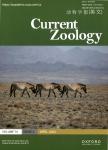Coat color and its effect on preference for the scent marks of opposite-sex conspecifics in the meadow vole Microtus pennsylvanicus
Coat color and its effect on preference for the scent marks of opposite-sex conspecifics in the meadow vole Microtus pennsylvanicus作者机构:Department of Biological Sciences The University of Memphis Memphis TN 38152 USA
出 版 物:《Current Zoology》 (动物学报(英文版))
年 卷 期:2012年第58卷第2期
页 面:221-227页
核心收录:
学科分类:0710[理学-生物学] 07[理学] 0905[农学-畜牧学] 09[农学] 0906[农学-兽医学] 071002[理学-动物学]
基 金:Supported by NSF grant NIH grant Supported by a NSF Science, Technology, Education and Mathematics (STEM) awarded to the University of Memphis
摘 要:Many mammal species can distinguish between opposite-sex conspecifics that differ in a certain trait. In that coat coloration is associated with differences in physiological and behavioral traits, coat color may affect the attractiveness of odor cues produced by conspecifics. Individuals may be able to respond preferentially to conspecifics with a particular coat color. In the present study, we test the hypothesis that scent marks of brown and blond voles differ in their attractiveness to male and female conspecifics. Male voles and brown females did not discriminate between blond- and brown-coated opposite-sex conspecifics suggesting that they are neither selecting potential mates dissociatively nor associatively. However, blond females behaved as if the scent marks of blond males were more attractive than were the scent marks of brown males. Our data suggest that blond females who are already conspicuous to predators, may select blond males as mates because they do not appreciably increase the risk of detection to predators, particularly avian predators. Moreover, because these conspicuous males have survived to mate they may have good genes that reflect their relatively higher quality [Current Zoology58 (2): 221–227 , 2012].



